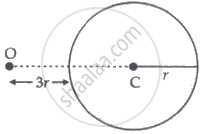Advertisements
Advertisements
प्रश्न
If there is a convex lens of focal length 75 cm and a concave lens of focal length 40 cm, then calculate their combined power and combined focal length.
उत्तर
Power of convex lens = `100/("f"("cm"))`
= `100/75` = + 1.33 D.
Power of concave lens = `100/("f"("cm"))`
= `100/40` = − 2.5 D.
Their combined power P = + 1.33 D + (− 2.5 D)
P = − 1.17 D.
Their combined focal length F = `100/"P"=100/(-1.17)`
F = − 85.47 cm.
Negative sign indicates that the nature of their combination is concave.
APPEARS IN
संबंधित प्रश्न
A convex lens forms a real and inverted image of a needle at a distance of 50 cm from it. Where is the needle placed in front of the convex lens if the image is equal to the size of the object? Also, find the power of the lens.
A converging lens has focal length of 50 mm. What is the power of the lens?
The optician's prescription for a spectacle lens is marked +0.5 D. What is the:
(a) nature of spectacle lens?
(b) focal length of spectacle lens?
A convex lens of power 5 D and a concave lens of power 7.5 D are placed in contact with each other. What is the :
(a) power of this combination of lenses?
(b) focal length of this combination of lenses?
On reducing the focal length of a lens, its power ______.
A normal eye is not able to see objects closer than 25 cm because
The power of the magnifying glass depends on the distance of the magnifying glass from object.
If focal length of a convex lens is 20 cm at what is the power of the lens?
Define power of a lens. What is its unit? One student uses a lens of focal length 50 cm and another of –50 cm. What is the nature of the lens and its power used by each of them?
A point object is placed at O in front of a glass sphere as shown in figure.

Show the formation of the image by the sphere.
